Astronomy in Ireland - Réalteolaíocht in Éirinn
As an Irish astronomer, St Patrick’s Day seems like an appropriate day on which to talk briefly about the history (and pre-history) of astronomy in Ireland. The Irish word for astronomy ‘réalteolaíocht’ is formed as a compound word from réalta (star) + eolaíocht (science).
Ancient Ireland
Irish people have, in spite of (or perhaps because of) the frequently cloudy weather, been fascinated with the night sky for millennia. While Stonehenge in the UK gets a lot of well-deserved fame and attention for its celestial alignments, which are a marvellous feat, it may come as a surprise to some readers to learn that on the other side of the Irish Sea, there lies an even older Neolithic monument, which also contains an alignment with the motion of the Sun.
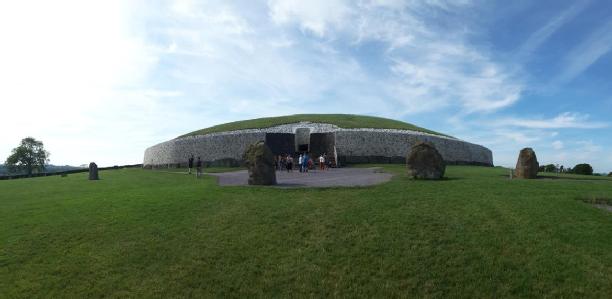
The Neolithic Monument of Newgrange. The people standing near the entrance give you a sense of scale of the earthworks involved in its construction. Image Credit: Dr Rok NežičLink opens in a new window
Newgrange (or in Irish ‘Sí na Brú’) is a Neolithic passage tomb. Passage tombs are common in Ireland, and are mounds of earth and stone with an inner chamber which are generally believed to have been used for ritual purposes such as worship, burials and cremations. It is estimated that Newgrange was constructed around 3200 BCE, making it 500 years older than both the Great Pyramid of Giza, and the stone circle of Stonehenge. The whole structure is 75-85 metres in width, and is about 12 metres high.
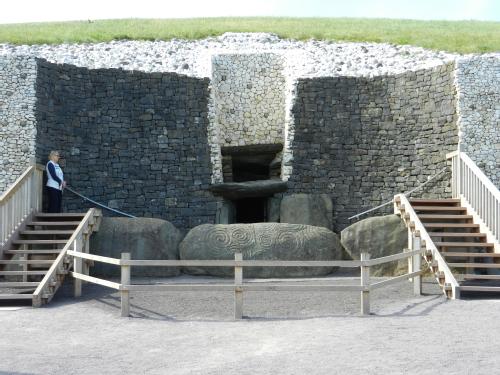
The entrance to Newgrange. The entrance has been somewhat restored since its rediscovery at the end of the 17th Century. The Roof Box can be clearly seen above the doorway. Image credit: Dr Rok Nežič
Perhaps the most significant aspect of the construction of Newgrange is the orientation of the immense structure. The entrance was constructed specifically so that, on the morning of the winter solstice, the first rays of sunlight shine through a specially constructed ‘Roof Box’ above the doorway, and illuminate the chamber. This shows the remarkable level of understanding that the ancient people of Ireland had of the motion of the Sun through the sky throughout the year, as well as the significance that this had in their lives. By marking the time of year when daylight was at its shortest, they could celebrate the fact that the darkness of winter had reached its peak, and that brighter days lay ahead. Shamefully, I must admit I have not actually visited Newgrange myself, but I do intend to visit one day! Understandably, there is always a keen interest in visiting on the morning of the winter solstice. Given the space within the chamber, only a very small number of people, usually chosen by lottery, are fortunate enough to witness the solstice sunrise, a number which is made even smaller by the unreliability of the weather in December!!
Much like the site around Stonehenge containing more than just a single stone circle, the area around Newgrange is rife with various other Stone Age monuments. As recently as 2018, aerial photography during a period of exceptionally dry weather revealed evidence of a henge-like construction, likely to date from around 2500 BCE.
News video report of 2018 discovery (Twitter)Link opens in a new window
The whole area, known as Brú na Bóinne (the bend in the Boyne [river]) is recognised as a UNESCO World Heritage Site, a tribute to its significance, not only to Ireland, but to the world, as a prime example of a Neolithic monument.
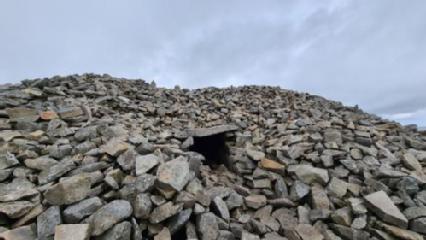
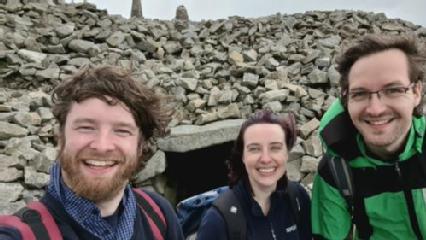
The Slieve Gullion Passage Tomb, highest surviving passage tomb in Ireland (573 metres above sea level), visited on a windy day in August 2021. Images are my own :)
Another example of a passage tomb can be found on the summit of Slieve Gullion in County Armagh. This tomb is the highest surviving example in Ireland, and the entrance passageway is aligned to face the setting sun on the winter solstice, rather than the sunrise as is the case in Newgrange. This one I can say I have visited, as you can see in the picture above! And having climbed to it in August when the weather is more hospitable, I will say that I have great respect for anyone who has been there at sunset on December 21st and has then had to navigate down off the mountain in the cold, wind and darkness! It is also colloquially referred to as Calliagh Birra's House, in reference to a divine being in Irish mythology, which I can't go into here without going wildly off-topic!
The Largest Telescope in the World
If I told you that for a period of more than 70 years, the largest telescope in the world was located in Ireland, would you think I was crazy? Well, it might be crazy, but it’s true. From the time of its construction in 1845 until the construction of the 100-inch telescope at Mount Wilson Observatory in California, the ‘Leviathan of Parsonstown’, with its 72 inch aperture, was the largest telescope in the world. The telescope was the brainchild of William Parsons, the 3rd Earl of Rosse (1800-1867), a wealthy Anglo-Irish landowner, whose family lived at Birr Castle, in County Offaly, in the centre of Ireland. The town of Birr, where the castle is located, was known as Parsonstown at the time, which is no mere coincidence!
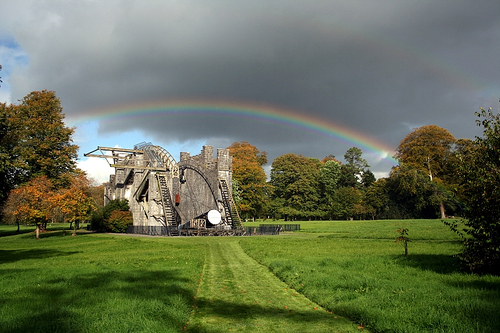
The Leviathan of Parsonstown (Image with Rainbow: Wikimedia Commons, public domain)
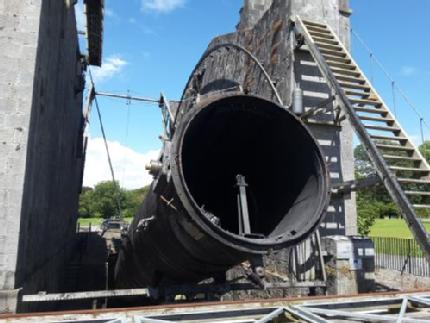
A close-up of the telescope tube, the eyepiece is noticeable on the left-hand side. Photo taken on the Armagh Observatory trip to Birr which I was unavailable for, so credit goes to Dr Rok Nežič for this photo!
The 3rd Earl of Rosse had a keen interest in astronomy, science, and engineering, and initially constructed a telescope with an aperture of 3 feet (36 inches). But this did not satisfy him, and in the 1840s, he began work on constructing something much larger, a telescope with a 72-inch aperture! This required a significant amount of ingenuity with the size of the telescope presenting several challenges to overcome. The tube of the telescope was mounted between two 12 metre high stone walls, with a number of weights, counterweights, winches and other devices to allow the telescope to be manoeuvred. Probably the largest challenge was producing the mirror. The telescope was built in the Newtonian design, with a large mirror at the base focusing the light onto a smaller mirror which directs the light to an eyepiece on the side of the tube. The Earl invented steam powered machines to assist in the grinding of reflective speculum metal to produce a mirror, but it took several attempts at grinding and polishing before he had a mirror which was suitable for use in his gigantic telescope.
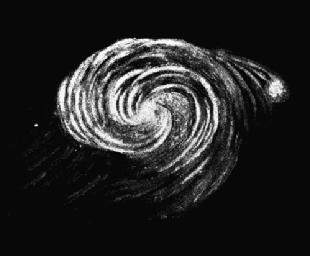

Lord Rosse's sketch of the Whirlpool Galaxy/M51 (1845, Public domain) compared to a Spitzer Space Telescope Image. The similarity is remarkable and is testament to the power of the Leviathan (and the Earl's patience and eyesight!) Spitzer Image credit: NASA
When all of this was said and done, was it worth the effort? The answer is most certainly, yes! The Earl was able to make detailed observations of faint objects in the night sky, which nobody before him had been able to do. Some of the Earl’s sketches have left a lasting impact on modern astronomy, which may be little-known or appreciated outside of Irish astronomical circles. One such example is the Whirlpool Galaxy, also known as Messier 51. His sketches of this ‘nebula’ as it was referred to at the time revealed the spiral (or whirlpool) nature of the object, and this would later come to be recognised as the first drawing of a spiral galaxy. It wasn’t until the work of Hubble (with the 100-inch Hooker telescope, which inherited the title of largest telescope) in the early 20th century that it was established that these nebulae were distant galaxies, rather than objects within our own Milky Way.

The Earl of Rosse's sketch of the Crab Nebula using the 36-inch telescope, 1844.
Maybe if you squint a bit you can see how it looks like a crab?
Credit: Philosophical Transactions of the Royal Society of London vol. 134 (1844), fig. 81 (plate xviii, p. 321)
The other significant sketch is that of the object known as M1. Have you ever looked at the Crab Nebula and wondered why it is called the Crab Nebula? Well, you can blame William Parsons for that one! Although in this case, it is a sketch based on observations with his 36-inch telescope, rather than the Leviathan. But even then, I’m not totally convinced I can see from his sketch how it looks anything like a crab!! The Leviathan continued to be used after the 3rd Earls death in 1867, by his eldest son, Laurence, the 4th Earl of Rosse, and the Danish Astronomer John Dreyer.
As with Newgrange, I should be ashamed to mention that I have not visited Birr. I have a good excuse this time though, as a trip was organised during the time of my PhD studies at the Armagh Observatory, but I could not go as it coincided with an important astronomical conference which I was attending.
Armagh Observatory
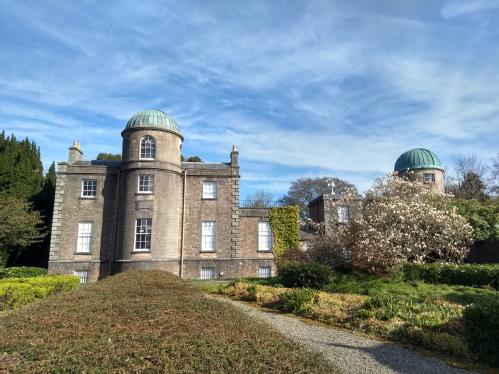
The southern façade of Armagh Observatory. Dating to 1790, the Georgian architectural style is clearly evident. The original building was symmetric about the dome in the left of the photograph, which houses the Troughton Equatorial telescope. Later additions were made to house more instruments, including the dome on the right, which was built in 1827. My own photo, from spring of 2020
Speaking of Armagh Observatory, I could write a whole article, or series of articles about the rich history of Armagh Observatory and the contributions to science and discovery that have been made by astronomers there since its foundation in 1790, but I will restrict myself to just a brief mention here. I am of course a little biased, but for a small observatory, I feel it has constantly punched above its weight in terms of contributions to science. The observatory was founded by the Archbishop of Armagh, Richard Robinson in 1790. Robinson envisaged founding a university in Armagh, but these plans never quite materialised. The innovative brass Troughton telescope of 1795 is the oldest telescope in the world still in its original dome!
A Robinson Cup Anemometer spinning in a light breeze at Armagh Observatory. The cup anemometer was invented as a device to measure the speed of the wind by Director Thomas Romney Robinson (no relation to Archbishop Robinson) after a severe windstorm known in Ireland as the 'Night of the Big Wind' on 6th January 1839, which caused widespread damage across Ireland and in Liverpool.
To cover just a small fraction of the contributions made by Armagh to the world of science I would have to mention the invention of the cup anemometer for measuring wind speed, and the publication of the New General Catalogue (NGC) by Dreyer, based on observations both with the Leviathan at Birr and telescopes at Armagh. The NGC is a catalogue of galaxies and nebulae which amateur and professional astronomers continue to refer to when observing.
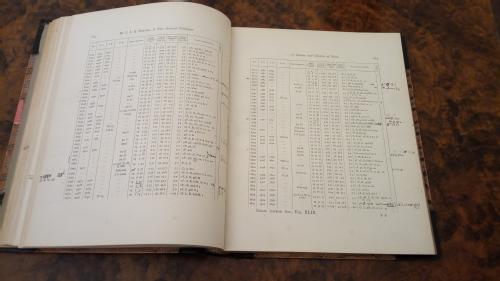
A rare opportunity to get up close and personal with John Dreyer's original author's copy of the first edition of the New General Catalogue of Nebulae and Clusters of Stars. Annotations are made throughout where Dreyer was making corrections in advance of the publication of a revised version of the Catalogue. Photo is my own.
Additionally, Armagh is home to the longest daily climate series in the UK and Ireland, with measurements dating all the way back to 1794. As you can imagine, as the world comes to terms with the climate crisis, this long data series is incredibly valuable in understanding how our climate has behaved over recent centuries. I am privileged to have played a role in recording some of these data during my time in Armagh.
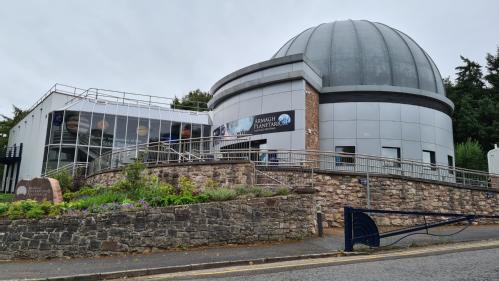
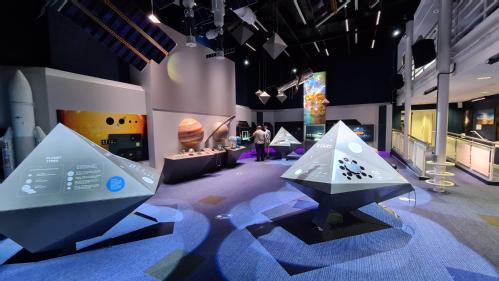
Adjacent to the Observatory, and part of the same organisation, the Armagh Planetarium, founded in 1968, is the oldest planetarium in the UK and Ireland. The exhibition area has been recently redeveloped and contains information on many aspects of astronomy and astrophysics and highlights areas of active research at Armagh Observatory. I can thoroughly recommend a visit (again, I’m definitely not biased!). Images are my own.
Modern Irish Astronomy
Astronomy (and astronomers) remain active across the island to the present day. Many universities in Ireland have astronomy departments, as well as the Dublin Institute of Advanced Studies, and the Armagh Observatory. Research is carried out in a broad range of topics, including Solar physics, planetary science, stellar physics, high-energy astrophysics and galactic and extra-galactic astrophysics. The Astronomical Society of Ireland, the representative body of professional astronomers on the island of Ireland hold a national meeting (INAM) annually for Irish astronomers to meet and present their latest results.
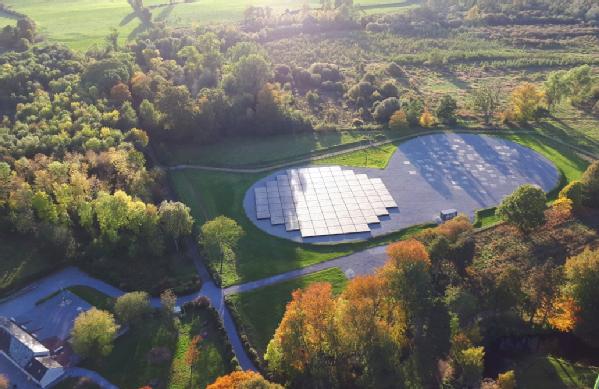
The I-LOFAR Radio array at Birr Castle. There are two types of antennae, both of which look unlike a conventional telescope, but are designed to detect very long wavelength radio waves from the Sun and energetic sources in the Universe. Image credit: Alison Delaney, Birr Castle
In recent years, astronomical observation in Ireland has made a revival with the construction of the low-frequency radio telescope array known as I-LOFAR in 2017. The I-LOFAR array is built on the grounds of Birr Castle, with the permission of the Parsons family who still live there, continuing the legacy of cutting edge science being done in Birr. While a bunch of antennae in a field is not usually what one imagines when asked to picture a telescope, this is exactly the kind of equipment which is needed when observing radio waves with very long wavelengths. I-LOFAR is also connected to the wider European LOFAR network, which allows the taking of high resolution radio astronomy which is roughly equivalent to using a dish the size of Europe! Ireland’s western location in Europe means that it plays an important role in extending the size of the array, and the telescope has been used to observe the Sun, as well as more distant sources of radio emission.
In conclusion, it is clear that Irish people have always been obsessed with observing the sky, and this passion for observing and documenting the Universe is still going strong after thousands of years!
Lá Fhéile Pádraig Sona Daoibh!
